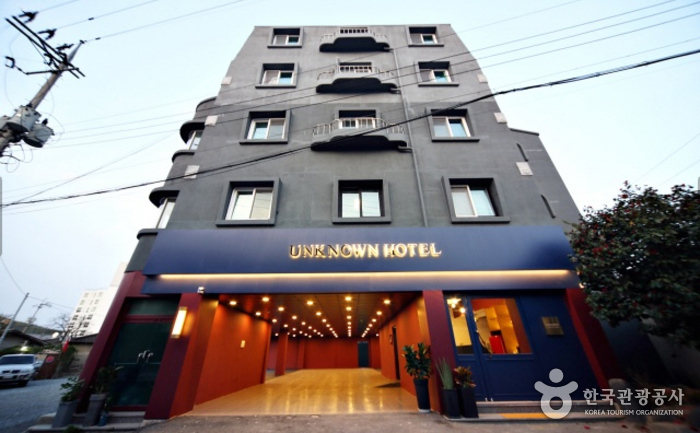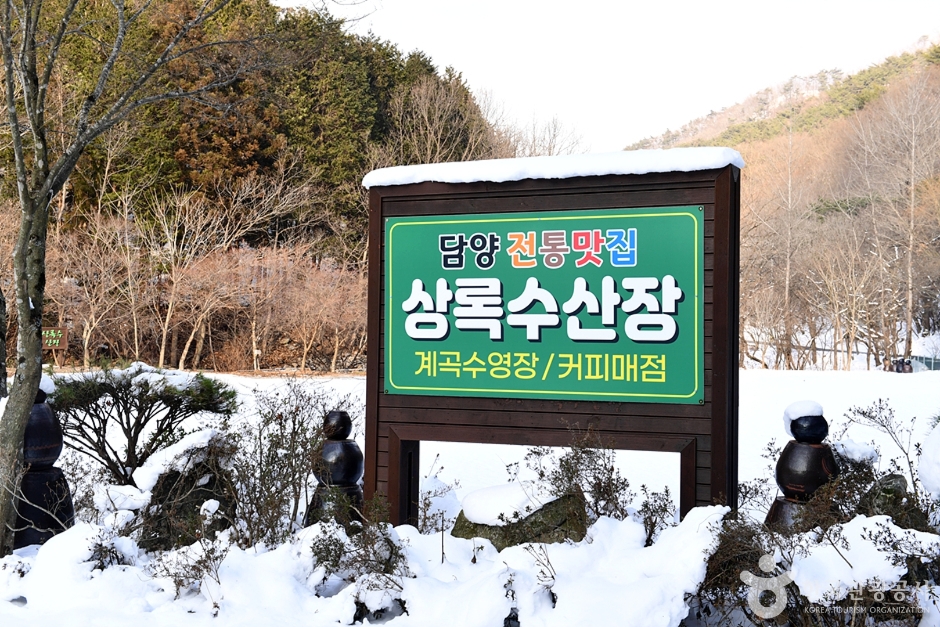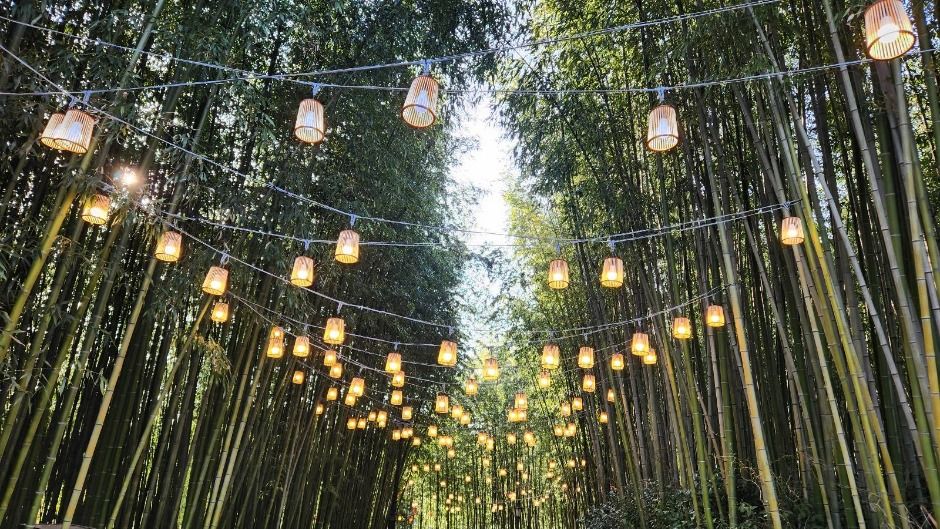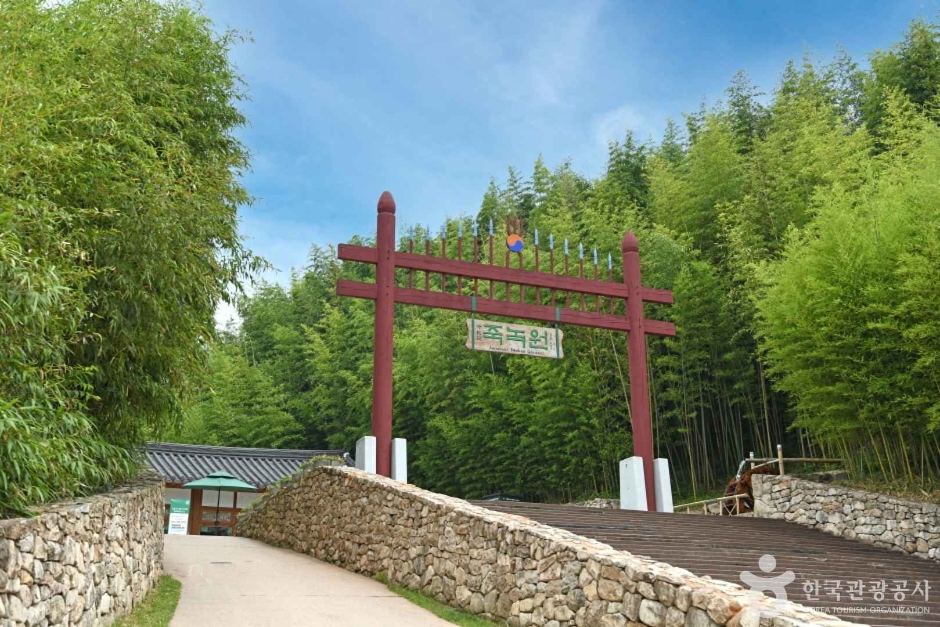Damyang Apzip (담양앞집)
17.0Km 2024-12-26
전라남도 담양군 담양읍 죽향문화로 22
This restaurant is famous for serving Damyang tteokgalbi (Grilled Galbi Patties), served alongside noodles. They use local produce and focus on enhancing the ingredients’ natural flavors. When you order tteokgalbi here, it’s presented on a large plate with a salad, much like a Western-style brunch. Their housemade noodles, crafted from a blend of buckwheat and Damyang bamboo leaves, are also a standout.
Unknown Hotel (언노운호텔)
18.1Km 2024-12-23
27 , Damju 1-gil, Damyang-gun, Jeollanam-do
+82-61-382-2600
The Unknown Hotel in Damyang, Jeollanam-do, stands out because of its dramatic use of color, inspired by the extraordinary light and color of Edward Hopper’s interiors. There is a range of rooms, all with comfy king-size beds. The Signature Room has two bedrooms and a living room with a six-person table suitable for meetings and family gatherings. Guests can rent a bicycle from the hotel and enjoy a bike ride to Juknokwon Bamboo Forest, Gwanbangjerim Woods, and Redwood Road.
Sinsikdang (신식당)
18.3Km 2024-12-26
전라남도 담양군 담양읍 담주2길 18-13
061-382-9901
Established in 1932, this restaurant has been passed down through four generations. One of its unique qualities is making its own fermented soybeans, soy sauce, and red chili paste, giving its dishes a rich and deep flavor.
Jungnimwon Garden (죽림원가든)
18.6Km 2024-02-19
358 Gasan-gil, Wolsan-myeon, Damyang-gun, Jeollanam-do
061-383-1292
Jungnimwon Garden offers traditional Korean flavors in a unique setting. Their signature dish is the Daetongyongjjim (Bamboo-steamed set menu), where various ingredients are steamed together in a long bamboo tube. This dish includes a variety of items such as Korean beef bulgogi, spicy braised chicken, prawn, grilled pork galbi, octopus, abalone, ray, yellow croaker, eggs, and rice served in the bamboo tube. Additionally, their daetongbap jeongsik (steamed rice in bamboo set menu) and hanu tteokgalbi (grilled Korean beef galbi patties) are also highly recommended.
Gwanbangjerim Forest (관방제림)
18.7Km 2025-01-09
1, Gaeksa-ri, Damnyang-gun, Jeollanam-do
+82-61-380-2812
Located in Damyang, Jellanam-do, Gwanbangjerim Forest (Natural Monument) is a forest that was made along the banks of Damyangcheon Stream. The two-kilometer-long forest stretches from Dongjeong Village in Namsan-ri to Hwanggeum-ri, Subuk-myeon and Gangui-ri, Daejeon-myeon.
Gwanbangjerim Forest is a special manmade forest that was planted to prevent flooding along Damyangcheon Stream. It is comprised of large trees such as muku trees, zelkova trees, nettle trees, and cherry trees that are about 200 to 300 years old.
The forest’s beauty is so well known that it was even selected as “Korea’s Most Beautiful Forest” by the Korean Forest Services. Visitors enjoy this gorgeous natural getaway all year round, with many stopping by the forest Sculpture Park for pictures. Nearby attractions include the Jungnogwon Bamboo Garden and the Metasequoia-lined road.
Sangnoksu Sanjang (상록수산장)
18.7Km 2024-02-19
378 Yongheungsa-gil, Wolsan-myeon, Damyang-gun, Jeollanam-do
Sangnoksu Sanjang is a restaurant located in the Yongheungsa Valley of Yonggusan Mountain in Damyang. Its signature menu is baeksuk (whole chicken soup). Visitors can enjoy this dish while dipping their feet in the cool waters of the valley during the summer, experiencing the unique Korean tradition of enjoying a healthy meal while refreshing oneself in the clear stream water and lush greenery of the forest.
Naju Pear Museum (나주배박물관)
18.9Km 2021-08-13
5838, Yeongsan-ro, Naju-si, Jeollanam-do
+82-61-339-2590
Known as the birthplace of Korean pears, Naju pears are well-known for its long history. The fruit was exported worldwide starting in 1967. The Naju Pear Museum promotes the fruit and is a learning center for its agricultural history. The museum opened on April 20, 1992 and is the world's only pear museum.
Damyang Bamboo Festival (담양대나무축제)
18.9Km 2025-07-11
134 Jungnogwon-ro, Damyang-eup, Damyang-gun, Jeollanam-do
+82-61-380-3152
In Damyang, a town where bamboo grows abundantly, there used to be a day when villagers gathered to plant bamboo, known as the Day of Jukchwi (bamboo planting day). This tradition has evolved into an annual festival celebrated in May since the Goryeo Dynasty. The festival takes place around the famous bamboo forest, Juknokwon, and the natural monument forest, Gwanbangjerim Forest. Various bamboo-related activities are available, such as making bamboo kites, shooting bamboo water guns, and riding bamboo rafts and canoes. A stroll through the bamboo forest, which emits phytoncides and negative ions, offers a relaxing charm during the festival. Visitors can also enjoy Damyang’s local food on the lawns, watch performances, and participate in various events, immersing themselves in the celebration of Damyang and bamboo.
◎ Day of Bamboo Planting
May 13 on the lunar calendar is a good day to plant bamboo. It is recommended that bamboo shoots be planted during the rainy season, as bamboo loves water.
Juknokwon (Bamboo Garden) (죽녹원)
19.0Km 2024-12-02
119 Jungnogwon-ro, Damyang-gun, Jeollanam-do
+82-61-380-2680
Juknokwon in Damyang is a bamboo forest cultivated by the town of Damyang. This bamboo forest, at approximately 160,000 ㎡ in size, was formed in May 2003. The rock steps and soft breeze blowing between the bamboo trees provide relief from daily stress. Try bamboo leaf tea for a perfect end to one's visit.
Damyang Meta Provence (담양 메타프로방스)
19.3Km 2023-01-17
2-17, Gipeunsil-gil, Damyang-gun, Jeollanam-do
+82-61-383-1710
Meta Provence is a tourist complex located in Damyang, Jeollanam-do, which attracts approximately 5 million tourists a year, and is located right next to Damyang Metasequoia-lined Road, once selected as one of Korea’s most beautiful tree-lined roads. It has an atmosphere just like that of the French city of Provence, a famous vacation destination. Meta Provence consists of fashion streets, design handicraft workshops, commercial spaces, banquet halls and many other open spaces where culture, art and business coexist to provide great experiences for not only individual tourists but also families and groups, and, through diverse and differentiated high-quality services, it strives to provide special memories and new experiences to all visitors.






 English
English
 한국어
한국어 日本語
日本語 中文(简体)
中文(简体) Deutsch
Deutsch Français
Français Español
Español Русский
Русский